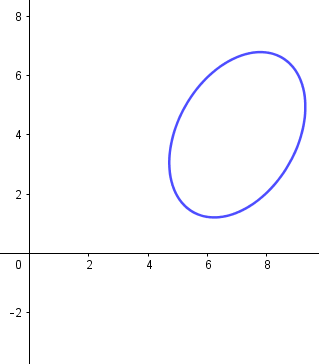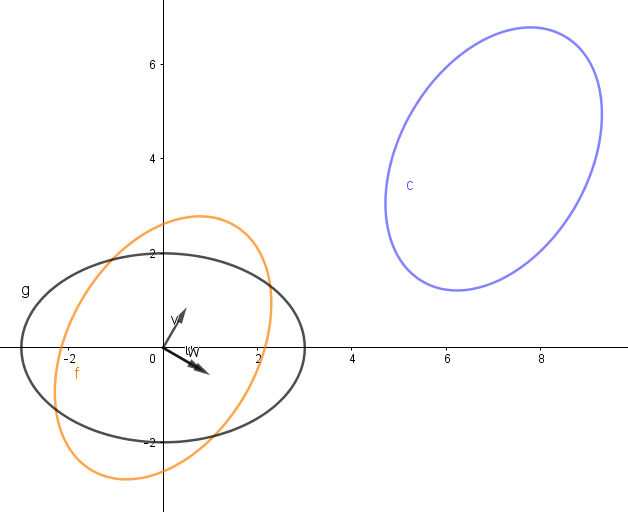Matrix Rectification

Our general form conic equation is $$Ax^{2}+Bxy+Cy^{2}+Dx+Ey+F=0 \tag{1} \label{1}$$ Suppose we begin with this ellipse equation: $$\begin{aligned} & -\frac{5}{18}\sqrt{3}(x-7)(y-4)\\ & +\frac{31}{36}(x-7)^{2}\\ & +\frac{7}{12}(y-4)^{2}=4.\\ \end{aligned} $$ so that the coefficients of the terms are easily identified, and just for the convenience of observation, we will print it with approximate values. $$\begin{aligned} &0.861x^{2} -0.481xy+0.583y^{2}\\ &-10.131x-1.299y=-34.056\\ \end{aligned}$$ We have been given the center of this ellipse, but in a more general case, we would need to find it. That is conveniently done by setting the gradient to zero and solving for $x$ and $y$ simultaneously. $$\nabla f=\left(\begin{array}{c} \partial f/\partial x\\ \partial f/\partial y \end{array}\right)=\left(\begin{array}{c} 1.722x-.481y-10.131\\ 1.166y-.481x-1.299 \end{array}\right)=0\qquad\left(\begin{array}{c} x\\ y \end{array}\right)=\left(\begin{array}{c} 7\\ 4 \end{array}\right)$$ This center point cannot be found for a parabola, but with an "axis aligned" parabola, we can set $\partial f/\partial x=0$ for the squared term and solve for $x$. Then in the parabola equation plug in the found $x$ and solve for $y$. That $(x,y)$ pair will be the vertex of the parabola.
Using the centerpoint, we can translate the ellipse to the origin. To do the translation, for $x$ substitute $(x+7)$ and for $y$ substitute $(y+4)$. The equation will then reduce to
$$-\frac{5}{18}\sqrt{3}xy+\frac{31}{36}x^{2}+\frac{7}{12}y^{2}=4.$$
Now we are going to take the coefficients $A$, $B$, and $C$ from $\eqref{1}$ and put them into a matrix, $Q$, as follows:
$$Q=\left(\begin{array}{cc}
A & \frac{B}{2}\\
\frac{B}{2} & C
\end{array}\right)=\left(\begin{array}{cc}
\frac{31}{36} & \frac{-5\cdot\sqrt{3}}{(18\cdot2)}\\
\frac{-5\cdot\sqrt{3}}{(18\cdot2)} & \frac{7}{12}
\end{array}\right)$$
Next we will find the eigenvalues of $Q$ using the characteristic matrix.
$$\left(\begin{array}{cc}
\frac{31}{36}-\lambda & \frac{-5\cdot\sqrt{3}}{(18\cdot2)}\\
\frac{-5\cdot\sqrt{3}}{(18\cdot2)} & \frac{7}{12}-\lambda
\end{array}\right)=0$$
$$\left(\begin{array}{c}
\lambda_{1}\\
\lambda_{2}
\end{array}\right)=\left(\begin{array}{c}
1\\
\frac{4}{9}
\end{array}\right)$$


Matrix alignment
Reference: Matrix representation of conic sections, Wikipedia, Wikimedia Foundation, October 2019, https://en.wikipedia.org/wiki/Matrix_representation_of_conic_sections
An aligned and origin centered ellipse can be accomplished as follows. Form matrix $Q$ as before. $$Q=\left(\begin{array}{cc} A & B/2\\ B/2 & C \end{array}\right)$$ Form a new matrix called A_{q}. $$A_{q}=\left(\begin{array}{ccc} A & B/2 & D/2\\ B/2 & C & E/2\\ D/2 & E/2 & F \end{array}\right)$$ Using $Q$, find the eigenvalues, $\lambda_{1}$ and $\lambda_{2}$. Now the aligned and origin centered ellipse will be $$\lambda_{1}x^{2}+\lambda_{2}y^{2}=\frac{-determinant(A_{q})}{determinant(Q)}$$